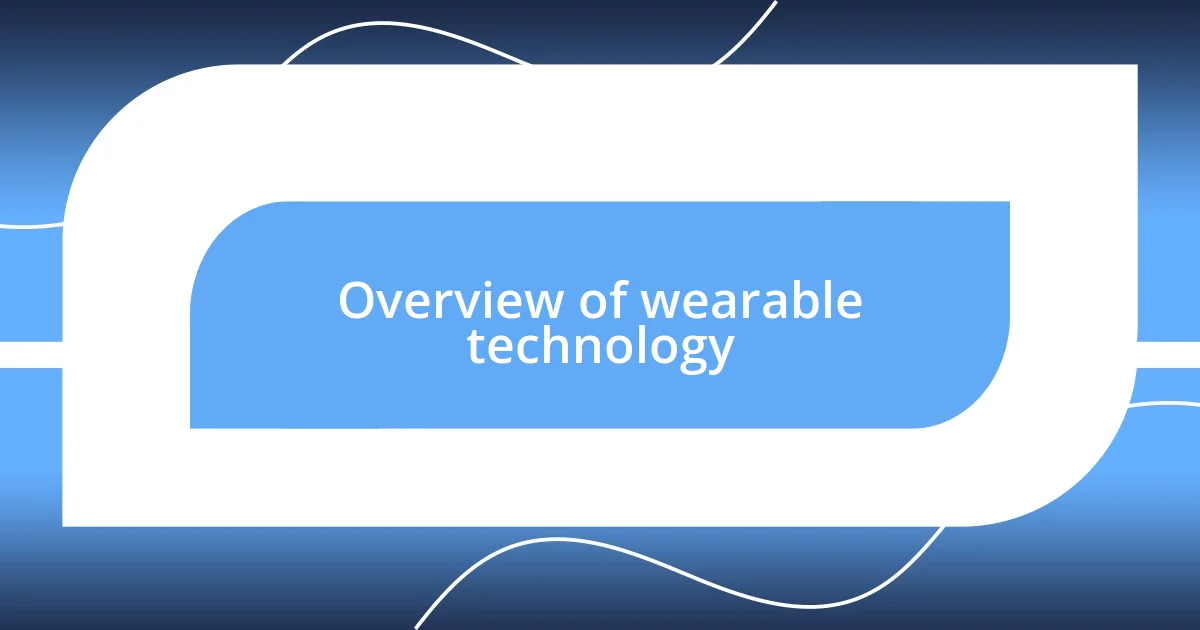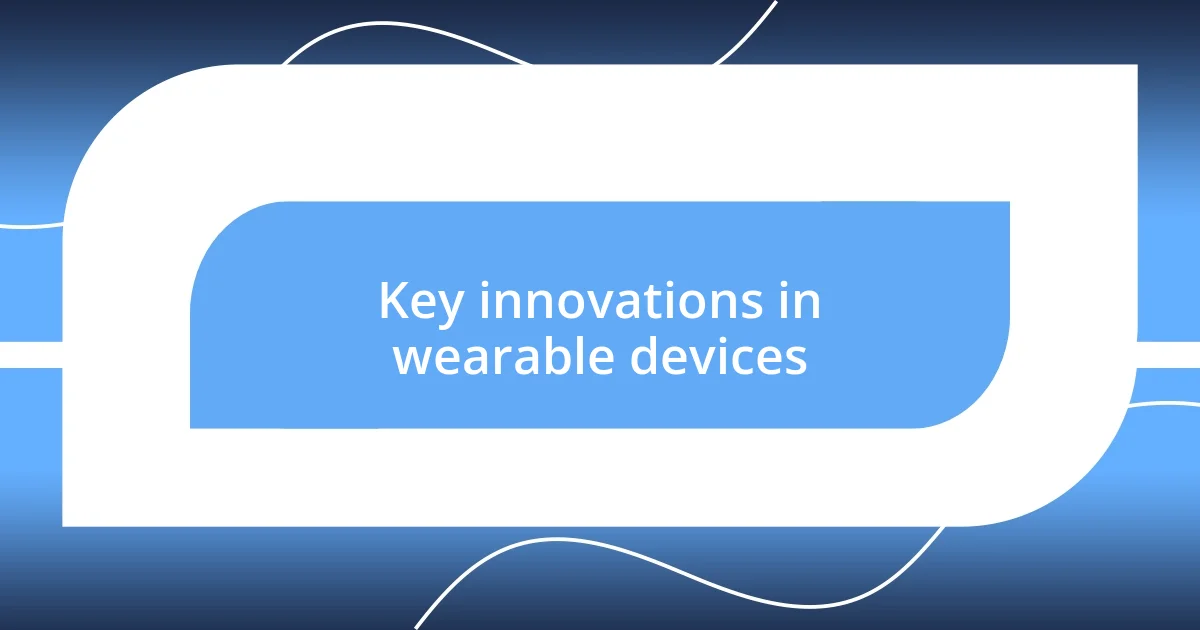Key takeaways:
- Wearable technology has evolved into essential health management tools, enabling real-time monitoring of fitness and chronic conditions.
- Key innovations include improved biometric sensors for accurate health tracking and the rise of smart fabrics that integrate technology into everyday clothing.
- Future wearables are expected to enhance personalization, connectivity with smart homes, and non-invasive health monitoring capabilities.

Overview of wearable technology
Wearable technology has swiftly transitioned from a novelty to an integral part of our daily lives. Think about it: with smartwatches and fitness trackers, we’re carrying around miniature computers that not only keep us organized but also provide real-time health data. I remember the first time I strapped on a fitness tracker; seeing my daily steps and heart rate made me feel more in tune with my body. It sparked a genuine curiosity about my health habits.
These devices range widely, from smart clothing to augmented reality glasses, all designed to offer convenience and insights at our fingertips. Each piece of wearable tech serves a unique purpose, like helping athletes enhance their performance or allowing individuals to manage chronic conditions more effectively. Isn’t it fascinating how this technology can empower us?
As I navigate through my day, I often ponder how much potential remains untapped in the world of wearables. The possibilities excite me! Imagine a future where we can have instant health check-ups right from our wrist, making healthcare more proactive rather than reactive. Each advancement seems to bring us closer to a world where personal health management is not just a goal but a daily reality.

Recent trends in wearable tech
Recent advances in wearable technology highlight a growing focus on health and wellness. I find it fascinating how smartwatches now not only track fitness but also monitor stress levels and sleep quality. This has made me rethink my own habits; ever since my smartwatch started alerting me to my sleep patterns, I’ve been more intentional about my bedtime routine.
Another significant trend is the integration of health monitoring features geared towards chronic disease management. For instance, wearables that track glucose levels or heart rate variability are game-changers for individuals with diabetes or heart conditions. Just a few weeks ago, a friend of mine shared how her continuous glucose monitor alerted her before her blood sugar dropped too low; it’s a bit surreal to think that technology can intervene in such critical moments.
Additionally, augmented reality wearables are on the rise, enhancing our interaction with the world around us. I remember the first time I tried AR glasses; the overlay of information on my physical environment felt like I was walking through the future. This kind of immersive experience not only entertains but also has practical applications, like providing real-time navigation or translating signs in a foreign language.
| Wearable Tech Type | Key Features |
|---|---|
| Smartwatches | Fitness tracking, health monitoring, notifications |
| Health Monitors | Chronic disease tracking, real-time alerts |
| Augmented Reality Glasses | Interactive overlays, navigation assistance |

Key innovations in wearable devices
When I dive into the latest innovations in wearable devices, one key development stands out: improved biometric sensors. These sensors now offer unparalleled accuracy in measuring vital signs like oxygen levels and heart rate variability. I remember testing a new smartwatch that showcased this technology; the readings were so precise that it felt like having a personal health assistant right on my wrist. This can genuinely empower users to make informed health decisions, resonating deeply with anyone who is health-conscious.
Also, the emergence of smart fabrics is quite remarkable. These textiles blend tech seamlessly into everyday wear, providing data without disrupting our routines. The experience of wearing a smart shirt during a workout, where it tracks my heart rate and muscle fatigue, changed my perspective on fitness monitoring. Here’s a quick overview of some key innovations in wearable tech:
- Biometric Sensors: Accurately track biometrics like heart rate, oxygen levels, and even body temperature.
- Smart Fabrics: Integrate sensors directly into clothing to monitor health metrics.
- Advanced Connectivity: Devices now sync effortlessly with health apps for comprehensive data analysis.
These innovations illustrate not just a trend, but a shift toward more personalized, intuitive health management that I find truly exciting.

Benefits of smart wearable technology
The benefits of smart wearable technology are incredibly compelling. One of the standout advantages is the ability to monitor health metrics in real-time. Recently, I was out for a run and noticed that my smartwatch alerted me to an elevated heart rate. This kind of immediate feedback not only informed my workout but also reinforced my commitment to my fitness goals. Isn’t it remarkable how a device on your wrist can help guide your health journey?
Another significant benefit is the potential for improved lifestyle choices. For example, I’ve found that wearable technology has nudged me toward making healthier decisions throughout the day. With reminders to stay hydrated or to take a break from sitting, I’ve become more aware of my daily habits. Have you ever had a moment when technology made you pause and think about your choices? It’s as if my watch is almost a personalized coach, keeping me accountable.
Lastly, the peace of mind that comes from using smart wearables can’t be overlooked. I recall a particular evening when my fitness tracker went off, alerting me to a potential sleep issue based on my overnight stats. Instead of just brushing it off, I decided to explore the data and adjust my bedtime routine. That small intervention not only improved my sleep quality but also enhanced my overall well-being. Can you imagine the impact of knowing that your device is looking out for your health, almost like having a guardian angel?

Challenges of adopting wearable tech
Adopting wearable tech isn’t without its hurdles. One major challenge I’ve encountered is the sheer barrage of data that these devices generate. I remember feeling overwhelmed when my smartwatch began providing detailed sleep analyses. Instead of feeling empowered, I found myself spiraling into a rabbit hole of metrics that just sparked anxiety. How do we balance the information flood with practical insights? That’s a question many users grapple with.
Another issue is the need for continuous updates and compatibility with other devices. I’ve experienced headaches syncing wearables with different apps, often leading to frustration. There’s nothing more disheartening than investing in what seems like a cutting-edge device only to find it doesn’t play well with my other gadgets. Have you faced similar tech compatibility woes? It can feel like a guessing game, and it certainly detracts from the seamless experience we crave.
Lastly, the privacy aspect looms large when discussing wearables. It’s unsettling to think about how much personal data is being collected. For instance, when I first set up my health tracker, I hesitated at the thought of sharing my health stats, worried about who might access that information. How do we ensure our health data is protected while still reaping the benefits of these incredible devices? It’s a conversation worth having as we navigate this digital health landscape.

Future predictions for wearables
The future of wearable technology is poised for significant advancements, particularly in health monitoring. I envision a time when wearables will not only track our steps or heart rates but also analyze blood chemistry using non-invasive techniques. Imagine receiving instant alerts for potential health issues while simply going about your daily routine! This could truly transform our approach to preventive healthcare.
Moreover, I anticipate that wearables will become even more integrated into our daily lives. For instance, I can see future devices evolving to connect seamlessly with smart home systems. Picture this: you walk through your door after a long day, and your wearable detects your stress levels and adjusts the lights and sounds in your home to promote relaxation. Wouldn’t that be a game-changer in managing daily stress?
Lastly, I believe that personalization will become a hallmark of future wearables. I often find myself wishing my devices could better tailor their interactions to my unique preferences and lifestyle. The ability to adjust algorithms based on my habits and needs could push us past generic health tracking into truly individualized health management. Have you ever thought about how much more effective our wearables could be if they were designed to understand us personally? That’s the exciting frontier we might be headed towards.

Practical tips for choosing wearables
Choosing the right wearable can be a daunting task, but there are some practical tips that have helped me navigate the options. First, consider what features matter most to you. For instance, when I first looked into fitness trackers, I was tempted by fancy bells and whistles. However, it turned out that all I really needed was a reliable step counter that could sync with my smartphone. What’s essential for your daily life?
Another factor to keep in mind is comfort. I recall my excitement when I bought a smart bracelet, only to find out it was uncomfortable during workouts. It would dig into my wrist, making it a hassle to wear for long periods. Trying on wearables before purchasing can truly make a difference. I always suggest taking a few minutes to see how it feels and fits—nothing is worse than buyer’s remorse when it comes to comfort!
Lastly, don’t forget to check for app compatibility. I once bought a health tracker without verifying the app it synced with. To my dismay, the app didn’t support my phone’s operating system, leaving me with a pricey paperweight. Researching your preferred app beforehand can save you from future headaches. Trust me, the last thing you want is a cool gadget that you can’t fully utilize. What experiences have shaped your approach to choosing wearables?











